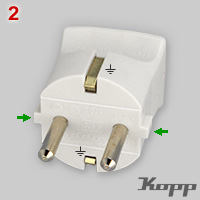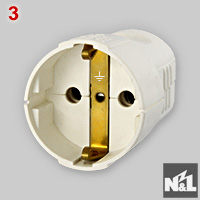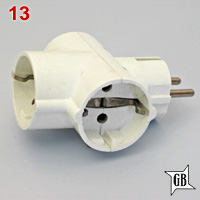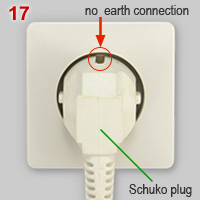 |
CEE 7/3 - 7/4 standard Schuko type plugs and sockets |
CEE 7… |
|
CEE
7/3 refers to sockets, CEE 7/4 to plugs. Plugs are characterized by
earth clips, rather than earth pin.
The standard, often indicated as
'Schuko' is adopted by a large number of continental European
countries. See map of Europe for
details.
General information of the "Schuko" standard is given at the bottom of page. Information of most manufacturers can be found in lists of companies. |
 |
Related
pages: uncommon types classic types Schuko-French hybrid types |
|
|
|
|
|
 |
 |
| 1 | CEE 7/3
(Schuko) type socket
with
two slots (line and neutral; not polarized) and two earth clips. All
types of
outlets are recessed (see nos. 1 and 3), to ensure that contact
between fingers and pins is not possible, even if plugs are not fully
inserted. Pairs of notches (arrows) and corresponding guides at the
Schuko plugs (see no. 2) give extra stability and guidance. Manufacturer: Merten, Germany (part of Schneider Electric). |
| 2 | CEE 7/4
(Schuko)
plug, rated at 16A, 250V. Line and neutral pins have a
diameter of 4.8 mm. Green arrows indicate the guides (see socket no. 1
for corresponding notches). Manufacturer: Heinrich Kopp GmbH, Germany. |
| 3 | Schuko
connector plug, rated at 10A (DC) / 16A (AC) - 250V. Manufacturer:
N&L Elektrotechnik GmbH, Germany. |
| 4 | Schuko plug with large grip to facilitate plug removal. Because of the position of the grip, the plug as a side cord entry rather than top entry. See also plug no. 5 that has a 90° rotated cord entry. Manufacturer has an unknown logo. |
| 5, 5a |
Dual,
flush mounted Schuko socket that
fits in a single wall mounting box. Standard round mounting boxes have
an inner
diameter of 62 mm (indicated in image 5a) and depth of 40 mm. Both
outlets have safety shutters, operating independently of each other.
Manufacturer: TEM Čatež, Velika Loka, Slovenia. {DS} |
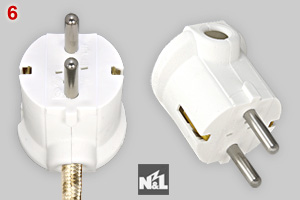 |
 |
| 6 | Schuko plug with cord side entry. Schuko
sockets are usually mounted
with outlet holes in a horizontal position next to each other; see
image no. 1. Orientation of cord entry of plug no. 4 results in a
vertical (downward) cord. Plug no. 5 has a 90° rotated cord entry. This variant can be useful in multi-plug outlet as shown in image no. 12. Manufacturer: N&L Elektrotechnik GmbH, Germany. |
| 7 | Schuko plug with a rotating ring to switch contact on and off. Another feature of the adapter is a 90° rotation of outlet position compared to plug pin position. This rotation is fixed and not related to switch position. Made by unknown Chinese manufacturer. |
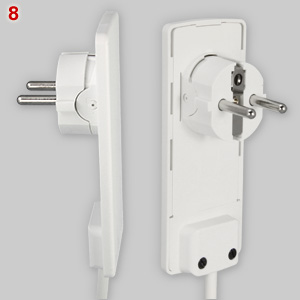 |
 |
8, 8a The EVOline® Schuko plug is a striking design by Schulte Elektrotechnik GmbH, Germany. Rating: 16A - 250V. The flat protrudes only 5 mm when fully inserted in a Schuko socket. The pin housing has a movable joint. This construction allows a simple removal of the plug; the flat plate can be as a lever (see image no. 8a).  |
  |
 |
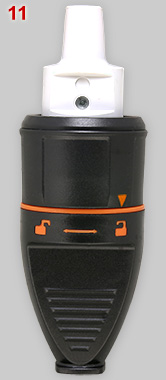 |
9 - 11 Connector plug with locking mechanism to prevent accidental disconnection. Rating: 16A - 250V. Images 9 and 10 show the connector in unlocked position, indicated by the orange triangle. After plug insertion, the locking mechanism can be activated by turning the collar (image 11). Once locked the connector can sustain 12 kg of force without disconnecting. See Electralock site for additional information. The shown Electralock model locks CEE 7/4 (Schuko), -7/7 (hybrid) and -7/17 (not earthed) plugs. The CEE 7/5-6 page shows a model adapted for French connectors that have an earth pin. Manufacturer: Electraline 3PMark S.p.A., Concorezzo (MB), Italy. {ARF} |
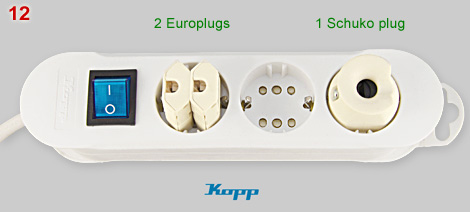 |
12 DUOversal '3=6' extension cord with a triple outlet. Each of the outlets can be used for either a Schuko plug, or two Europlugs. Rating: max.16A - 250V. A version with six outlets ('6=12') exists also. Manufacturer: Heinrich Kopp GmbH, Germany. {KB} Note that the "3=6" principle is not allowed in the Netherlands. The reason for this is that Dutch regulations stipulate that each outlet may only have two contacts (one for L-pin, the other for N-pin). |
|
|
 |
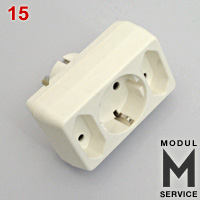 |
| 13 | Schuko
three-way
multi-plug. Manufacturer: Gebrüder Broghammer, Germany. |
| 14 |
Extension
cord with
triple outlet and plug with switch adapter and indicator light. Note
that slots are protected by shutters (red). Safety shutters are not (yet?) compulsary in the Netherlands. |
| 15 | Multi-plug
for Euro
and
Schuko plugs. There are many variants on this theme. Manufacturer: Modul Service, a yet unknown company (or brand name). |
| Not earthed
sockets and Schuko plugs |
|
|
|
 |
 |
| 16,
17 |
Non-earthed socket (no. 16) that accepts Schuko plugs (no. 17). This practice causes a potentially unsafe situation, because the Schuko earth clips do not make contact with an earthing system. Preferably non-earthed sockets of this type should have a provision that makes them inaccessible for Schuko plugs; see nos. 21 and 22 for examples. |
| 18 | A provision
against Schuko plugs is occasionally found on outlets of non-earthed extension cords. The green arrows point to fins at
positions that correspond to earth clips of a Schuko plug. These fins
make it impossible to insert a CEE 7/4 (Schuko) or CEE 7/6 (French)
plug. A simple but effective
safety measure that forces people to use a three-wire extension cord
with male and female earthed plugs.
Manufacturer: Ningbo Kaifeng Electrical Appliances Co., China. |
| 19 | Multi-outlet
of an extension cord that is only suitable for not earthed CEE 7/16 and
CEE 7/17 plugs. Not earthed CEE 7/2 (model with round base) and earthed
CEE 7/4 (Schuko) and
CEE 7/6 (French) plugs do not fit in the outlets. Note that one of the
fins has been broken off (deliberately?). The outlet has been made in France by BRUN. Details about
the company are unknown. This rare
multi-outlet has been found in 2014 in Marseille by Wojciech Maciak. |
| About
Schuko Schuko is an abbreviation of the German word "Schutzkontakt", which means protective contact. Two important safety features are: (i) plugs have earth clips that make contact first, and (ii) sockets are recessed; pins under tension can't be touched. The original design of a safe, earthed plug and socket was an idea of Albert Büttner (Bayerische Elektrozubehör in Lauf). Patent was granted in 1926. Plugs had earth clips rather than a (third) earth pin. Further developments resulted in a version that was patented in 1930 by the Siemens-Schuckerwerke in Berlin. The patent describes the plug and socket that is still in use and became known as Schuko. Schuko is a registered trademark of the SCHUKO-Warenzeichenverband e.V., Bad Dürkheim, Germany. A separate page gives the full story of the origin of Schuko. The Schuko system has proved to be very solid, but being unpolarized - line and neutral are reversible - is often regarded as a disadvantage. Note that polarized Schuko plugs exist, but they seldom used. An example is shown on the page about uncommon plugs. Schuko plugs are indicated by a CEE code, given by the International Electrotechnical Commission for Electrical Equipment. Relevant CEE numbers are: CEE 7/3 = Schuko 16A-250V socket (see no. 1) and CEE 7/4 = Schuko plug 250V-16A, (see no. 2). CEE 7/7 = Schuko-French hybrid plug are shown on a separate page. Essentially the same Schuko devices are used in Russia and eastern European countries, except Poland, Czech Republic and Slovakia. Plugs may have several country specific marks. Read about their origin and significance on the certification marks page. |

